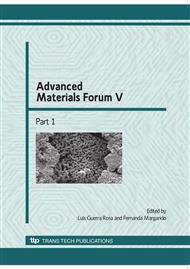[1]
B.M. Kulwicky, Humidity sensors, J. Am. Ceram. Soc. 74 (1991), pp.697-708.
Google Scholar
[2]
S. Yang, J. Wu, Ceramic Humidity Sensors,J. Mater. Sci. 26 (1991), pp.631-636.
Google Scholar
[3]
S.M. Sze, Semiconductor Sensors, John Wiley & Sons, New York, (1994).
Google Scholar
[4]
E. Traversa, Ceramic sensors for humidity detection: the state-of-the-art and future developments, Sensors and Actuators B 23 (1995), pp.135-156.
DOI: 10.1016/0925-4005(94)01268-m
Google Scholar
[5]
R. Lalauze, C. Pijolat, High-sensitivity materials for gas detection, Sensors and Actuators vol. B8, pp.237-243, (1992).
DOI: 10.1016/0925-4005(92)85024-q
Google Scholar
[6]
G. Fu, H. Chen, Z. Chen, J. Zhang, Humidity sensitive characteristics of Zn2SnO4-LiZnVO4 thick films prepared by the sol-gel method, Sensors and Actuators B 81 (2002), pp.308-312.
DOI: 10.1016/s0925-4005(01)00971-6
Google Scholar
[7]
J.H. Anderson, G.A. Parks, Electrical conductivity of silica gel in the presence of adsorbed water, J. Phys. Chem. 72 (1968), pp.3362-3368.
Google Scholar
[8]
E. McCafferty, A.C. Zettlemoyer, Adsorption of water vapour on Fe2O3, Faraday Soc. 52 (1971), pp.239-263.
Google Scholar
[9]
E. Traversa, A. Bearzotti, A novel humidity-detection mechanism for ZnO dense pellets, Sensors and Actuators B 23 (1995), pp.181-186.
DOI: 10.1016/0925-4005(94)01271-i
Google Scholar
[10]
T.Y. Kim, D.H. Lee, Y.C. Shim, J.U. Bu, S.T. Kim, Effects of alkaline oxide additives on the microstructure and humidity sensitivity of MgCr2O4--TiO2, Sensors and Actuators B 9 (1992), pp.221-225.
DOI: 10.1016/0925-4005(92)80220-r
Google Scholar
[11]
Y.C. Yeh, T.Y. Tseng, D.A. Chang, Electrical properties of porous titania ceramic humidity sensors, J. Am. Ceram. Soc. 72 (1989), pp.1472-1475.
DOI: 10.1111/j.1151-2916.1989.tb07679.x
Google Scholar
[12]
J. E. Bauerle, Study of Solid Electrolyte Polarization by a Complex Admittance Method, J. Phys. Chem. Solids 30 (1969), pp.2657-2670.
DOI: 10.1016/0022-3697(69)90039-0
Google Scholar
[13]
J.R. MacDonald, Impedance Spectroscopy, John Wiley & Sons, New York, (1987).
Google Scholar
[14]
P.M. Faia, C.S. Furtado, Impedance Spectroscopy characterisation of Indium and Tin oxide thick film composites, Materiais 2007, Porto - Portugal.
Google Scholar
[15]
Agilent Technologies, Impedance measurement handbook, Agilent Technologies Co. Ltd (2002-2003).
Google Scholar
[16]
Agilent Technologies, 4294A Precision Impedance Analyzer, Agilent Technologies Co. Japan (2002).
Google Scholar
[17]
M. Bayhan, N. Kasasoglu, A study on the humidity sensing properties of ZnCr2O4-K2CrO4 ionic conductive ceramic sensor, Sensors and Actuators B 117 (2006), pp.261-265.
DOI: 10.1016/j.snb.2005.11.053
Google Scholar
[18]
K-S. Chou, T. -K. Lee, F. -J. Liu, Sensing mechanism of a porous ceramic as humidity sensor, Sensors and Actuators B 56 (1999), pp.106-111.
DOI: 10.1016/s0925-4005(99)00187-2
Google Scholar
[19]
H. Baltes, W. Göpel, J. Hesse, Sensor Update, Volume 1 VCH, (1996).
Google Scholar
[20]
W. Kingery, H. Bowen, Introduction to Ceramics, John Wiley and Sons, (1976).
Google Scholar
[21]
S. Morrinson, The Chemical Physics of Surfaces, Plenum Press, (1977).
Google Scholar
[22]
D. Kohl, Surface Mechnism in the detection of reducing gases with SnO2 Based devices, Sensors and Actuators, 18 pp.71-113, (1989).
DOI: 10.1016/0250-6874(89)87026-x
Google Scholar
[23]
B.M. Kulwicki, Humidity sensors, J. Am. Ceram. Soc. 74 pp.697-708, (1991).
Google Scholar
[24]
P.M. Faia, C.S. Furtado and A.R. Ferreira, Humidity sensing properties of a thick-film titania prepared by a slow spinning process, Sensors and Actuactors B (101) pp.183-190, (2004).
DOI: 10.1016/j.snb.2004.02.050
Google Scholar
[25]
C.S. Furtado, P.M. Faia and A.R. Ferreira, Studies on the sensing properties of TiO2-WO3 thick film humidity sensors, Materiais 2005, Aveiro - Portugal.
Google Scholar


